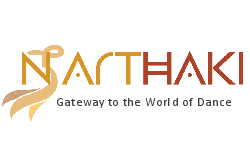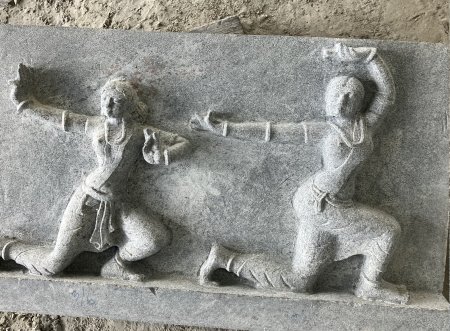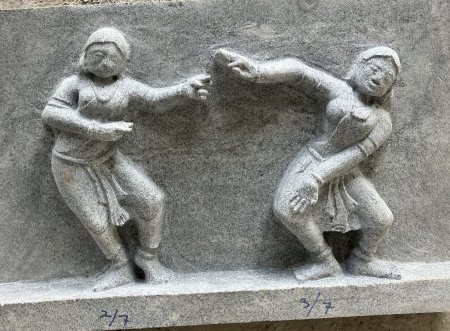
|
 |

|
 |
Natyacharya V.P.Dhananjayan's conceptual offering - 'Noothana Karanas' - Dr. Vinod Gopalakrishnan February 26, 2025 NEW NRITTA / NRITYA KARANAS ATTRACTION AT DAKSHINACHITRA, THE HERITAGE MUSEUM AT MUTTUKKADU, CHENNAI Bharata Kalanjali has installed a few Noothana (new) Karana sculptures at Dakshinachitra, Chennai, and more are to be added in due course. Senior Natyacharyas are invited to join this monumental project by installing new nritta /nritya Karanas created by them in their choreographic work. This will benefit present and future generations to understand the changing nature of arts from generation to generation. For more details, contact Natyacharya V.P. Dhananjayan (9884429828 / bkalanjali@gmail.com).  The Installation The displayed installation you see here today is a dream project envisaged by Natyacharya V.P. Dhananjayan. Over 7 decades and more, his work in performance, conceptualization, choreography, and collaboration have provided him with a wealth of experience that has transformed him into a global artist. He has also been committed to have his work documented and the efforts of the brilliant duo have been feted across India and the world. Over the years, he has contributed an immense dossier of articles to various publications across the world and a number of articles have been written about the brilliant work and career of the Dhananjayans. The Context 'Bharatanatyam' as a classical dance form has been in practice over the centuries and the form follows the monumental and unparalleled art treatise familiar to the world of art as Natya Shastra said to have been authored by Bharatamuni, the great sage of dance in India. It is also the earliest text that presents the term Karana as the basic unit of dance. 'Hasta Pada Sama Yogaha, Nrttasya Karanam Bhavet' When the hand and feet together along with a particular and specific course of movement, accompanied by specific 'Nritta Hasthas' (hand gestures) constitute what is known as a 'Karana'. This is found in the Natya Shastra and has also been adapted into later treatises such as the Sangita Ratnakara, the Bharatarnava and also in the Nritta Ratnavali. Post Natya Shastra, Indian history has offered several texts including the Abhinaya Darpana. Translated as 'The Mirror of Gesture', this text was authored by Nandikeshwara and continues to be the principal treatise that offers a set of technical application directives for Natya or dance across the classical performing arts of India. The directives of the Abhinaya Darpana are didactic in nature and are to this day followed by informed Gurus, teachers, performers and practitioners to define the basic positions for the performance of Bharatanatyam. These directives have historically been based on the ten basic Mandala Sthanas or postures as prescribed in text of the Abhinaya Darpana. The term Adavu in Bharatanatyam first appears in the Tamil classical text titled Koothanool which is known to have been written in the 5th century BCE. Post that period, the textual reference to the same term Adavu appears much later during the period of the Marathas and it is the ruler Tulaja I who is known to have authored the book Sangita Saaramrita and mention of the term Adavu as a basic unit of dance. The Adavu involves three basic features: 1. Posture to commence a movement. 2. The course of movement and the hand gestures that complement it. 3. The 'mnemonics' that go with it. In the context of dance tradition, the Nattuvanars or teachers across the various schools prevalent then were key in teaching and training in Bharatanatyam or Sadir (as it was called then), The Nattuvanar who belonged to a 'dance instructor' community were also said to have (over the years of work), created a whole set of Adavus that would form the base to create a whole set or units of dance that when combined held the strength to create a larger body of work. These Adavus have been recorded in both the Devanagiri and the Tamil script with descriptions on usage and execution. The definition of Adavu as the basic unit in the Koothanool and Sangita Saaramrita is quite different from the basic unit delineated in the Natya Shastra where it is defined as the Karana.   The Installation Unlike the original Natya Shastra Karanas found in Chidambaram temple, these 'Nava Karanas' or 'Noothana Karanas' you see on display are a new set of 'Nritta Karanas' based on the present day steps employed in the performance of Bharatanatyam. These are postures from which the rhythmic movements evolve incorporating the 'anga' (whole body), the Pratyanga (major limbs), and Upanga (minor limbs) etc. The treatise also lists other elements such as the Hasta, Pada, Vaksha, Parsva, and Kati to name a few. As our world has progressed from ancient times to the current period that we live in, there is a need for future generations to understand the changes across time from the period of the Natya Shastra to the present day. This is an imaginative exercise and more such newly evolved stone carved images of rhythmic movements could be added in the forthcoming generations of creative natya practitioners. These new Karanas as and when they are imagined can also be given separate names in Samskritam or Tamil following the original Natya Shastra Karana names or newly coined nomenclature for identification. That is left to the imagination of performing artists or scholars. This monumental work is a legacy of Bharata Kalanjali and the life's work of Natyacharyas V.P. Dhananjayan and Shantha Dhananjayan. Innovation has been the hallmark of their work and practice in their art. It is erected here at Dakshinachitra in the interest of public display to support the importance of art education, awareness and inspiration. More info: Nava Karanaani: A new series of nritta movements crystallized - V.P. Dhananjayan Responses * Master Dhananjayan ji's pioneering work in the field of classical dance has paved the way for significant advancement in the dance field that indeed leaves a lasting legacy. It is so inspiring. Thank you so much. Namaskar - Shila Mehta (March 5, 2025) * Dhanyavadah, Dhananjayan Master. Will be a treasure indeed for all of us - Dr. Padmaja Suresh (March 1, 2025) Post your comments Pl provide your name and email id along with your comment. All appropriate comments posted with name & email id in the blog will also be featured in the site. |